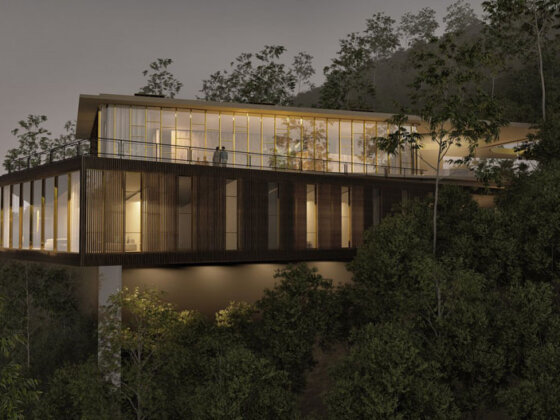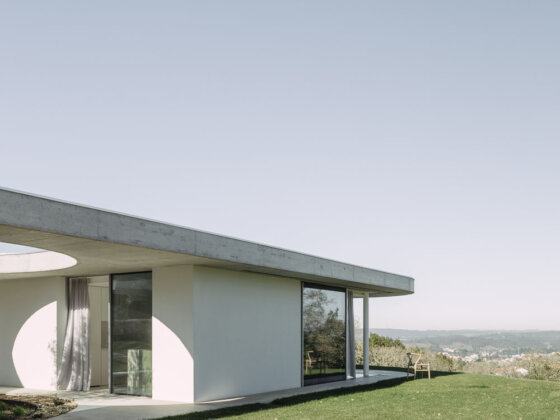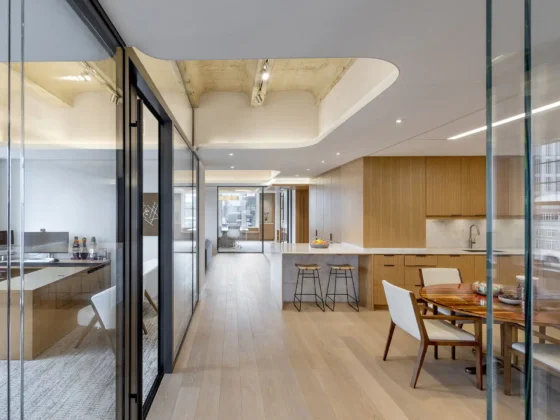Kingdom of Saudi Arabia
Article by Christian Narkiewicz-Laine
With sustainability as a founding principle, Saudi Arabia’s 30-year Neom project has the main goal to reshape the construction industry, creating a futuristic blueprint for planning, designing, and building that would make Daniel H. Burnham’s “Make No Little Plans” pale by comparison.
Participating architects to date include Zaha Hadid Architects, INJ Architects, On-A, Mecanoo, UNStudio, Aedas, Morphosis, LAVA, and Bureau Proberts (Reportedly, Norman Foster has withdrawn from the project).
Announced by Crown Prince and Chairman of the Council of Economic and Developmental Affairs Mohammad bin Salman bin Abdulaziz Al-Saud in 2017, Neom has plans that focus on five different fundamentals: sustainability, community, technology, nature, and livability.
As a cornerstone of Saudi’s Vision 2030 and with phase one of the project already nearing completion, this project will have a massive impact on the region and will pioneer the future of city design and be an economic engine for the Kingdom, as it will drive diversification and aims to contribute 380,000 jobs and $48 billion to domestic GDP by 2030.
Neom has been envisioned as a “living laboratory” made up of towns and cities, ports and enterprise zones, research centers, sports and entertainment venues, and tourist destinations.

Ultimately, the Neom megacity—divided into four tourism projects and led by a team of the brightest minds in architecture, engineering, and construction—seeks to make the idea of building upwards a reality resulting in three new tourist mega projects and a new city for over 9 million inhabitants.
The project, located in the far north-west of Saudi Arabia and constructed in the Emirate of Tabuk along 460km of coastland that includes marine land located within the Egyptian and Jordanian borders, seeks to combine technology, entrepreneurship, science, and innovation to create a new city with limitless opportunities.
Further up the Red Sea coast from this “industrial hub,” Neom has announced plans for the world’s largest coral reef restoration project.
Spearheading the plan is Roger Nickells, Head of Design and Construction, with 30 years of leadership experience at Buro Happold and Atkins Group, where he led transformational projects such as the Louvre in Abu Dhabi, London’s Battersea Power Station, and Mercedes Benz Stadium in Atlanta.

Joining Nickells is Antoni Vivesm, Chief Urban Planning Officer and former Deputy Mayor of Barcelona.
Neom, meaning “new future” in Arabic, certainly fits the name.
Projected to cover 10,230 square miles on the Red Sea in northwest Saudi Arabia, this large-scale project plans to create an environment where humans and technology can interact and reinvent the future in aspects such as energy, mobility, manufacturing, agritech, health, and livability.
The designated location offers diverse terrain, with long beaches, valleys, deserts, and mountain views, all with an average 10 Celsius cooler climate than the rest of the countries in the Gulf Cooperation Council, making it ideal for future residents.
One of Neom’s fundamentals is mobility for tourists and residents.

The project plans to use its strategic location to become the centre of world trade and be accessible to 70% of the world’s population in under eight hours through its recently constructed Neom Airport.
With already 10% of the world’s trade flowing through the Red Sea, other major hubs like London will be five hours away, Dubai and Cairo two, and Zurich five and a half, using the new airport.
Neom will also be constructing high-speed transit and on-demand shared mobility using already-developed digital infrastructure that will allow all neighborhoods in the city to be connected and accessible.
This, along with carefully designed street plans that prioritize walking and cycling will allow mobility throughout the entire city for residents and eliminate personal driving as a priority.

The new connections between neighborhoods and whole countries will allow the integration of new cultures within the city and spread inclusivity and progress.
Another key goal of Neom is for it to become a lead example of sustainable city practices.
It is projected that two-thirds of the world’s population will live in an urban area by 2050.
To combat our current climate crisis, Neom aims to reinvent the future of wind and water energy.
Neom aims to use strong sea breezes from the Red Sea as a competitively priced renewable energy source and develop a smart transmission and distribution network with the latest and most advanced technologies.

The other sustainable source of energy Neom can rely on is water.
With more than 450 kilometres of coastline, Neom has a vast supply of seawater to use for water production, storage, fertilizer, and reusable freshwater for irrigation thanks to Neom’s extensive knowledge of desalination research.
The engineers and architects of the project are focused on developing a water distribution network entirely connected through advanced interoperable modular systems to ensure minimal water loss.
Neom also plans to use solar power to provide energy for the city.
The city has the potential of using 20 MJ/m2 of perennial solar resources thanks to its desert location.
Solar, along with wind and water energy will launch Neom into becoming one of the most sustainable cities in the world.

The Four Neom Mega-Projects include:
Sindalah, which is the first physical showcase of Neom—as the vision becomes a reality.
An incomparable island destination, it will be an exclusive gateway to the stunning Red Sea that welcomes the global yachting community, as well as visitors looking for exquisite luxury.
With unforgettable experiences above and below the water and great connectivity to the nearby Mediterranean, in addition to spectacular golfing, Sindalah will provide year-round delights thanks to its perfect climate.
The resort includes a beach club, yacht club, spa and wellness centre plus 51 luxury retail outlets—in addition to luxury hotels and a large marina.

The second mega-project is Trojena, part of Neom’s regional plan, located 50km from the Gulf of Aqaba coast in the heart of the natural region—with elevations ranging from 1,500m to 2,600m and covering an area of nearly 60 square km.
Designed by German architecture practice LAVA, Trojena is an iconic, world-class destination, blending natural and developed landscapes and offering unique human-centric experiences for residents and visitors alike.
The destination will house six distinctive development districts centered around tailored experiences that blend real with virtual architectural and engineering innovations.
LAVA’s destination will house six distinctive development districts centered around tailored experiences that blend real with virtual architectural and engineering innovations… All to create a destination like no other on earth.
Capitalizing on the different climate in the area, where winter temperatures drop below zero celsius and year-round temperatures are generally 10 degrees cooler than the rest of the region—with its clear fresh air and stunning views—Trojena will not only be a mesmerizing place to visit, but also a magical place to live and work.

On completion, the development will also contain a broad range of homes, including apartments, chalets, and mansions, plus hotels ranging from ultra-luxury and experiential to wellness and family resorts.
In addition, there will be a wide range of retail, leisure, and dining options.
Activities including year-round skiing, water sports, hiking, and mountain biking will sit side-by-side with an interactive nature reserve

The third Neom project is Oxagon, designed to be the largest floating structure in the world with 13 percent of global trade passing through the Suez Canal and will serve as a new paradigm where people, industries, and technology come together in harmony with nature.
The city also aims to host a population of 90,000 residents and create 70,000 jobs by 2030.
The 100 percent clean energy city will be a hub of reimagination for work, living, and overall sustainability.

Bringing together state-of-the-art approaches of industry 4.0 and the circular economy, the project will create factories of the future for products of the future.
This will be a place where innovators and entrepreneurs can accelerate ideas from labs to market, and a city where people come together to live, work, and play—in thriving communities.
The fully automated next-generation port offers unparalled connectivity to global markets, enabled by an integrated physical and digital supply chain.

Finally, as part of the Neom project, the architects of Morphosis are planning a massive megastructure called The Line.
The Line is to be composed of two parallel skyscrapers that stretch for 170 km, from the Red Sea shore through the desert toward the mountains.
It will be 200 meters wide and soar to a height of 500 meters (higher than most of the world’s towers) and will be faced on all sides with gigantic mirrors.

“This design,” states Saudi Crown Prince Mohammed bin Salman, “will challenge the traditional flat, horizontal cities and create a model for nature preservation and enhanced human livability.”
“The Line will tackle the challenges facing humanity in urban life today and will shine a light on alternative ways to live.”
Morphosis’ new city is slated to house nine million people, and contain shopping and leisure sites, schools, and parks.
The predominantly horizontal design contains homes and shops with a transportation system that will connect both ends of the city and run on renewable and sustainable sources of energy.

The Line is the central feature of the huge Neom plan for Saudi Arabia that includes agricultural and industrial areas, tourist attractions, and an airport.
According to the developers, the urban design focuses on people and not on infrastructures, and walkability will define everyday life: all essential daily services, such as schools, medical clinics, leisure facilities, as well as green spaces, will be within a 5-minute walk.
The Line calls to mind the design for the floating pool from the 1970s, which appeared in architect Rem Koolhaas’s book “Delirious New York”—resembling an elongated, endless, and pointless Manhattan block.
Perhaps the most significant inspiration for the new project came from the Italian Superstudio collective, which at a 1972 exhibition at the Museum of Modern Art displayed a series of images of massive structures superimposed on famous natural sites and also on New York City itself, as a protest against contemporary architectural trends.
The images of structures that Superstudio created with sealed and smooth facades that resemble the mirrors resemble The Line as envisioned by Morphosis.
The entire project is slated for completion in 2050.

Project: Neom
Architects: ON-A architects, LAVA (Trojena), Morphosis (The Line)
Head of Design and Construction: Roger Nickells
Chief Urban Planning Officer: Antoni Vivesm













